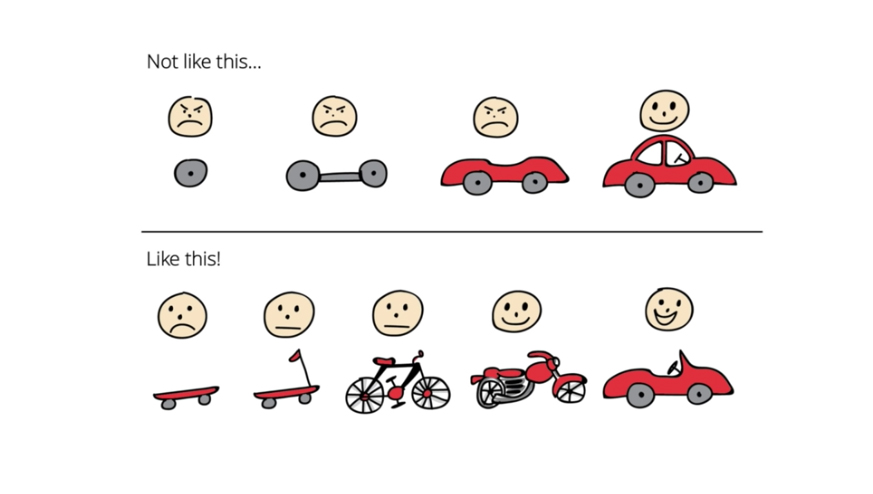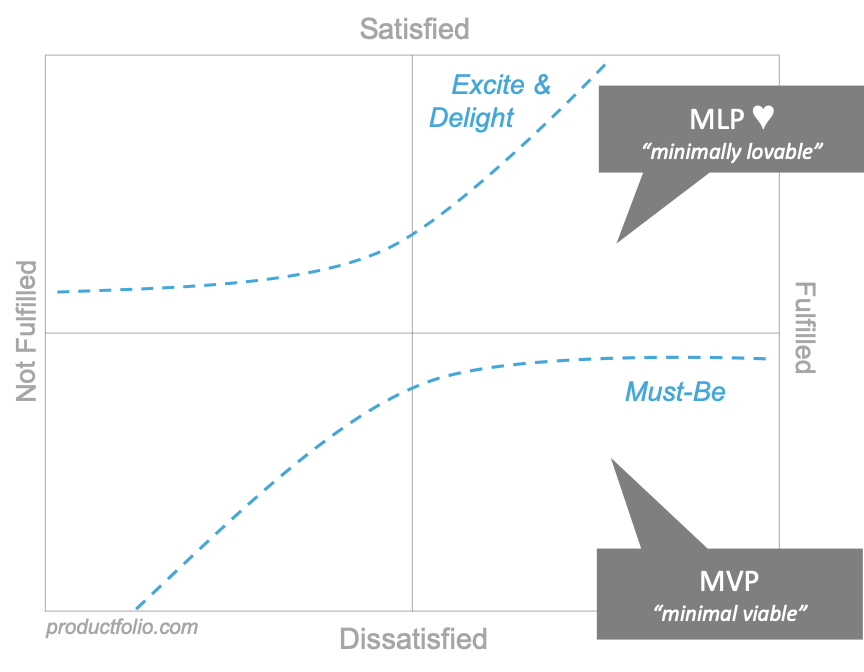What is an MVP?
A Minimal Viable Product (MVP) is a product that is introduced into the market in the early stages of development, in order to elicit feedback and find product-market as quickly as possible. A similar concept of the Minimal Loveable Product (MLP) seeks to determine the amount of buzz and excitement a product will create in the market. In both cases, the goal is to avoid spending all of your resources building out the product in its entirety before determining if it will succeed. MVP (and MLP) are examples of Lean methodology to get feedback early and often, rather than waiting until then end.
Minimal Viable Product in detail
The MVP concept was popularized by Eric Reis, author of The Lean Startup. The MVP approach provides a Product Manager with the maximum amount of validated learning about your customer’s needs with the minimum amount of time and resources expended. By putting your product into the hands of the users in the very early stages you potentially prevent having to build aspects of the product that may have been unnecessary.

There is the well-known example of the skateboard and the car product release. In this example, a customer needs a solution to get to work each morning. If you deliver just a wheel to the customer, this will not work and is not a viable solution. The prototype you deliver should be minimal, but not so minimal (like just a wheel) that is does not solve the customers’ needs. A skateboard would be an example of an MVP. It’s a small start that helps to solve the customers’ needs. The next release can then be a bike, then a motorcycle, and finally a car. By delivering prototypes in stages, you can learn what features the customer finds necessary.
Minimal Lovable Product in detail
While an MVP allows you to determine what your customers needs, The MLP helps you to determine what your customer wants. With the car and skateboard example, you were able to learn from the customer what was viable, which was a skateboard, a bike or a motorcycle. The loveable product for the customer is the convertible car. Yes, the bicycle works, and a car with a roof works. By releasing the prototype early when it was a skateboard you were able to gain insight and feedback from the customer that they enjoy fresh air on their commute but would like to speed up their commute. This leads to a convertible, which is a loveable product for your customer. The measure of a Minimal Loveable Product is if your product is adored so much by your users that it creates buzz and they get people to talk about it. Tesla is great at delivering MLP prototypes and creating a buzz. Tesla relies on delivering products their customers love and letting their customers do the advertising through social media engagement.
The key reason to start small is that it allows you to determine which features your users’ love, and which features are unnecessary. If you deliver a bloated product into the market that is packed full of features, it will be hard to determine which features are essential. When you have a clear idea of what your customers like and don’t like, pivoting is easier.

MVP/MLP and the Kano Model
It can be helpful to visualize the difference between an MVP and an MLP by looking at where they fall on the Kano Model. With the Kano Model, the Minimal Viable Product is along the “must-haves” arc, and the Minimal Loveable Product falls on the “delighters” curve. The reason it’s helpful to refer to the Kano Model is to keep in mind that “delighters” over time often become “must-haves”, this is called reversal. By referring to the Kano Model you can see the importance of striking the right balance between the “must-haves” and the “delighters”, which is why it’s advantageous to first introduce your MVP to your users followed up by the MLP. This will allow you to first determine your customers’ needs and then their level of satisfaction.
The Lean approach to MVP/MLP
Delivering Minimal Viable Products and Minimal Loveable Products using the lean approach is to develop as little as possible and start by seeking answers. The goal is to test your hypothesis with your product to determine if what you think the market wants is true. This can be done by having a one on one conversation, creating surveys, and building lean beta versions. The lean approach is geared toward saving the PM/PO from developing a product that could potentially be a failure. Saving time, resources and heartache.
Downfalls of MVP and MLP
There are a couple of problems with the MVP approach that can occur. This approach can be an excuse to throw junk products into the market that are not inspiring to users. Putting junk into the market does not validate anything, and can actually create false negatives, making it more difficult to discover good products.
Another common problem is that people end up building functional sections of a product without building the whole thing. Think of the wheel vs. the skateboard example. A wheel is a functional product, but without the board on top of it creating a skateboard, the wheel is of no use to the user. It’s important to be intentional about the overall product that you’re putting into the market, otherwise, it will waste your time as well as clutter the market.
The last and most common problem is that the MVP becomes a convenient justification for taking a phased waterfall approach to building something. The goal is not to simply phase out development you already have planned to do — it is to receive feedback that will determine your next steps.
In Conclusion
Working in an agile way to first determine the viability of a product, followed by determining the product’s lovability will help you to pivot early on and avoid unnecessary time and resources going towards your product.